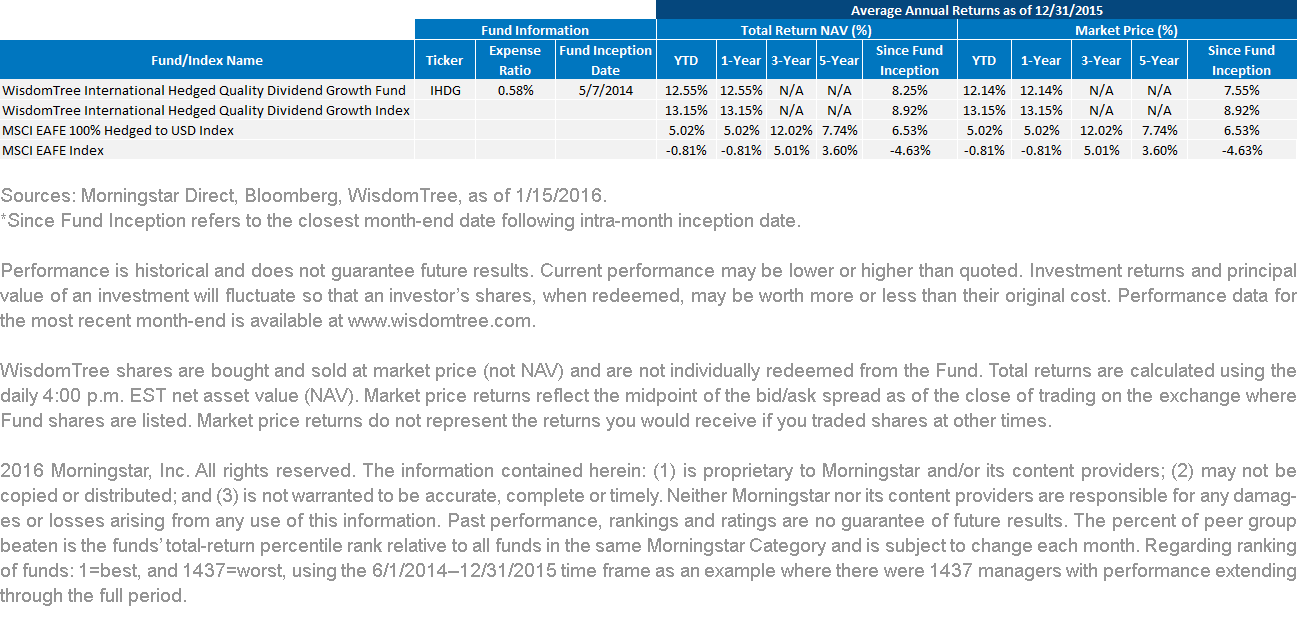Is Your Mutual Fund Manager Managing Currency Risk?



 The MSCI EAFE 100% Hedged to USD Index beat 95% of the active managers over the last year, 100% over the last three years, and 98% over the last five years. This tells us, indirectly, that the vast majority of active managers have not been managing the currency call. In fact, when we searched for the best-performing open-end fund over the last year, we found that it was a WisdomTree exchange-traded Fund, the International Hedged Quality Dividend Growth Fund (IHDG), which actually beat the MSCI hedged benchmark, and more than 1,400 mutual funds in the process.
So why didn’t more active managers manage foreign currency risk more effectively over this period?
We think some didn’t because they don’t believe, philosophically, that hedging currency adds value over time—even if there may be seven- or eight-year periods when currency moves can work for or against them. Some didn’t because they believe there is a cost to hedging that works against them. Though this may be true in certain periods, today the cost of hedging in the developed world is virtually nil, and over the last 30 years, the differential in interest rates between the foreign currencies within MSCI EAFE Index and the U.S. dollar has actually favored U.S investors. Some active managers may not hedge currencies because they are more comfortable making stock calls rather than currency calls. And many are benchmarked against unhedged indexes, and so, for them, hedging a currency is an active decision they may not wish to make.
But in a world at risk for deflation, making a permanent bet against the dollar—which is what 100% unhedged positions do—may not be in investors’ best interest.
Increasingly, advisors are making the decision for themselves. In just a few years, the percentage of the $360 billion invested in developed world equity ETF assets that hedge out currency has increased from virtually 0% to roughly 17%. But with the vast majority of active international mutual funds (representing more than $1 trillion in assets under management) still predominantly unhedged, the migration into 100% hedged or dynamically hedged strategies may still lie ahead.
For those who delegate the decision to an active manager but are disappointed with their ability to do so effectively, WisdomTree has created a family of hedged currency Indexes and dynamically hedged currency Indexes that make the decision regarding when and how much to hedge for you. WisdomTree’s underlying Index for IHDG mitigates the risk of currency exposure each month. Dynamically hedged indexes have the ability to rebalance the currency exposure each month based on three signals: momentum, interest rate differentials and relative value between currencies, ranging from 0% hedged to 100% hedged based on purchasing power parity.
Learn more about WisdomTree’s approach to dynamic currency hedging in the developed world.
Unless otherwise notes, data source is Bloomberg, as of 1/31/2016.
The MSCI EAFE 100% Hedged to USD Index beat 95% of the active managers over the last year, 100% over the last three years, and 98% over the last five years. This tells us, indirectly, that the vast majority of active managers have not been managing the currency call. In fact, when we searched for the best-performing open-end fund over the last year, we found that it was a WisdomTree exchange-traded Fund, the International Hedged Quality Dividend Growth Fund (IHDG), which actually beat the MSCI hedged benchmark, and more than 1,400 mutual funds in the process.
So why didn’t more active managers manage foreign currency risk more effectively over this period?
We think some didn’t because they don’t believe, philosophically, that hedging currency adds value over time—even if there may be seven- or eight-year periods when currency moves can work for or against them. Some didn’t because they believe there is a cost to hedging that works against them. Though this may be true in certain periods, today the cost of hedging in the developed world is virtually nil, and over the last 30 years, the differential in interest rates between the foreign currencies within MSCI EAFE Index and the U.S. dollar has actually favored U.S investors. Some active managers may not hedge currencies because they are more comfortable making stock calls rather than currency calls. And many are benchmarked against unhedged indexes, and so, for them, hedging a currency is an active decision they may not wish to make.
But in a world at risk for deflation, making a permanent bet against the dollar—which is what 100% unhedged positions do—may not be in investors’ best interest.
Increasingly, advisors are making the decision for themselves. In just a few years, the percentage of the $360 billion invested in developed world equity ETF assets that hedge out currency has increased from virtually 0% to roughly 17%. But with the vast majority of active international mutual funds (representing more than $1 trillion in assets under management) still predominantly unhedged, the migration into 100% hedged or dynamically hedged strategies may still lie ahead.
For those who delegate the decision to an active manager but are disappointed with their ability to do so effectively, WisdomTree has created a family of hedged currency Indexes and dynamically hedged currency Indexes that make the decision regarding when and how much to hedge for you. WisdomTree’s underlying Index for IHDG mitigates the risk of currency exposure each month. Dynamically hedged indexes have the ability to rebalance the currency exposure each month based on three signals: momentum, interest rate differentials and relative value between currencies, ranging from 0% hedged to 100% hedged based on purchasing power parity.
Learn more about WisdomTree’s approach to dynamic currency hedging in the developed world.
Unless otherwise notes, data source is Bloomberg, as of 1/31/2016.
Important Risks Related to this Article
There are risks associated with investing, including possible loss of principal. Foreign investing involves special risks, such as risk of loss from currency fluctuation or political or economic uncertainty. To the extent the Fund invests a significant portion of its assets in the securities of companies of a single country or region, it is likely to be impacted by the events or conditions affecting that country or region. Dividends are not guaranteed, and a company currently paying dividends may cease paying dividends at any time. Investments in currency involve additional special risks, such as credit risk and interest rate fluctuations. Derivative investments can be volatile, and these investments may be less liquid than other securities, and more sensitive to the effects of varied economic conditions. As this Fund can have a high concentration in some issuers, the Fund can be adversely impacted by changes affecting those issuers. The Fund invests in the securities included in, or representative of, its Index regardless of their investment merit, and the Fund does not attempt to outperform its Index or take defensive positions in declining markets. Due to the investment strategy of this Fund, it may make higher capital gain distributions than other ETFs. Please read the Fund’s prospectus for specific details regarding the Fund’s risk profile.
Hedging can help returns when a foreign currency depreciates against the U.S. dollar, but it can hurt when the foreign currency appreciates against the U.S. dollar.


